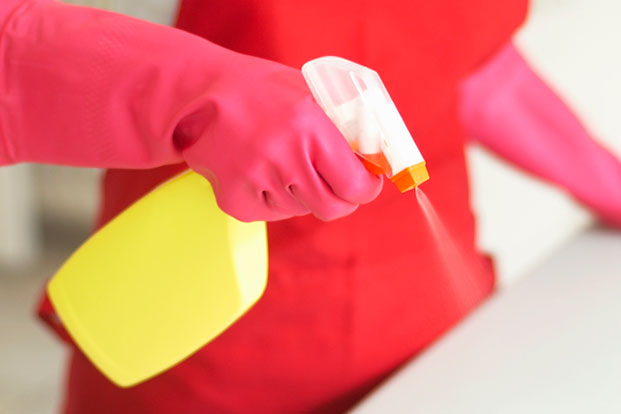We all know the signs: that stuffy nose and sore throat that quickly become a fever with chills, nausea, fatigue and body aches. You, or someone in your household, has come down with the flu. Influenza, or seasonal flu, is a highly contagious respiratory illness that affects between 5 and 20 percent of the population of the United States, with 4,000 to 49,000 American deaths each year.
Unlike the common cold, the flu tends to come on quickly and unexpectedly, with severe symptoms that affect the nose, throat, and lungs. While most people who contract the flu will be able to recover at home in under two weeks, using home remedies, about one in four flu sufferers will develop complications, including pneumonia.
Even in households where all relatives are within safe ages and are otherwise healthy, there are steps that you should take when you or a household member has come down with the flu.
Practice Defensive Medicine
The Centers for Disease Control and Prevention (CDC) advise that anyone who can should get an annual seasonal flu vaccine, especially those who fall into the high-risk category for developing complications from the virus. Not only can the flu vaccine prevent you and your family members from coming down with the flu, but also if you do happen to contract a strain against which you haven’t been vaccinated, your bout with this disease may be much milder than in someone who hasn’t been vaccinated.
The vaccine is the best line of defense for younger household members and may help keep the flu out of your home if you have a young infant, a relative who is undergoing chemotherapy or who otherwise has a compromised immune system, or if you have an elderly relative in the home or under your care.
There has been no risk associated with pregnant women getting vaccinated against the seasonal flu, and the vaccine has been shown to protect the mother during her pregnancy and may even pass along the immunity to her child for up to six months, until the child is able to get his or her own flu vaccine.
Get Healthy
When flu season is approaching, consider adding daily vitamins and other supplements to the family’s routine, if they aren’t already a daily part of it. Vitamin E and garlic supplements have been shown to reduce the risk of developing the flu, while vitamin C and zinc supplements have shown efficacy in minimizing symptoms or reducing the duration of symptoms by a day or more.
Minimize the Invasion
Once the flu has invaded your home, one of the first things you should do is establish a “sick room,” keeping the sick person comfortable but away from common areas in the house. When possible, the sick person or people should use a bathroom separate from those used by healthy people in the home.
The sick room and bathroom should be cleaned daily with a household disinfectant, such as Lysol, which may kill the flu virus on surfaces. No high-risk household members (young children, the elderly or anyone with a compromised immune system) should have contact with the sick person to minimize the risk of spreading the illness to someone who may develop a serious complication.
Each sick person should have his or her own drinking glass, washcloth and towel, and all needed materials, including tissues, garbage can, thermometer, humidifier, and cooler or pitcher with ice and drinks should be kept in the sick room to minimize the risk of contaminating a common surface in the house while looking for one of these items in a bathroom, kitchen or other room.
Wash Hands Frequently and Sanitize
All healthy people in the house should clean their hands with soap and water frequently, and use an alcohol-based hand sanitizer, especially after any contact with the sick person or any items used or touched by the sick person (including dishes and linens). The sick person should wash hands frequently with soap and water and avoid touching common surfaces after coughing into his or her hands.
Follow Safe Caregiver Protocol
Avoid being face to face with the sick person when possible. If you have sick children who need to be comforted, hold them with their chins on your shoulders so that they will not cough in your face and wash your hands and torso well and sanitize after contact. Keeping an alcohol-based hand sanitizer on bedside tables or dressers is a great way to remind yourself to keep your hands clean.
When washing clothing or linens the sick person used, you should avoid hugging them to your body to minimize your risk of contracting the virus. Instead, use a laundry basket and wash clothing and linens on the hot setting.
When washing dishes, when possible, run the dishes through a dishwasher with a heated dry or sanitize setting to kill off the virus before reusing them on a healthy family member.
When to Take Extra Precautions
Certain populations are at a higher risk of developing potentially deadly complications from the flu, which can lead to hospitalization and death. Of all of those risk factors, age seems to be the highest risk, with senior citizens (those aged 65 and over), infants and young children (especially those under the age of two) being at the highest risk for complications.
Other risk factors that may expose you or a loved one to risks of complications from the flu can include:
Chronic illness, such as heart disease
Weakened immune system, from medications (such as chemotherapy) or HIV
Pregnant women
Working in healthcare
Working in childcare
Living or working in a nursing home
If you have a loved one who falls into one of these high-risk categories and someone in your household develops the flu, you should contact your health care provider and ask whether or not the high-risk relative, as well as other household members, should begin taking antiviral medications to prevent getting the flu or minimize its effect.

Leave a Reply